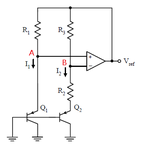juice9
Newbie level 2


Hi guys,
Greetings from Juice!
I am new here and seeking for some help on the op-amp based bandgap reference.
I tried to analyze the polarity of the op-amp used in a bandgap reference.
My understanding is the function of op-amp is to force the voltages at the two input to be the same. So in the graph, when voltage at point A increase, I1 increases, and in order to make point B voltage follow point A voltage to increase, the op-amp output need to increase. In this way, point A should be positive input. But this can't explain why op-amp output need to drop if point B voltage increases.
So can you kindly help to explain how the polarity of the op-amp is decided?
Thanks!



